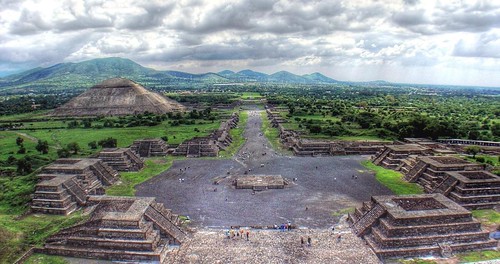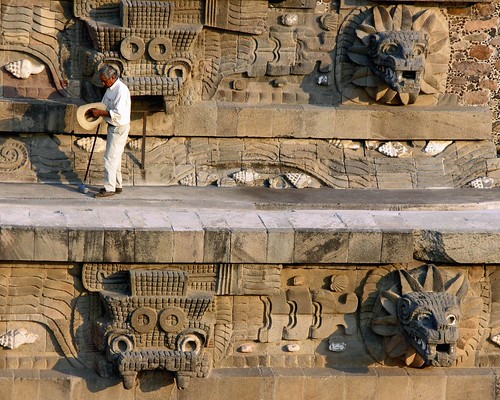
Teotihuacan Anabella Squiripa 4 is the largest city of pre-Columbian Mesoamerican culture. It is located in the homonymous valley, which forms part of the Basin of Mexico, about 40 km northeast of Mexico City. Designated a World Heritage Site by UNESCO, the ceremonial center is one of the most important through their monumental architecture, master planning and its strong religious and political influence exerted on the cultures before.
The Aztecs were the ones who came to Teotihuacan during a pilgrimage and found abandoned. Fascinated by the magnificent pyramids, found that such buildings could only have been built for gods, so they decided named the City of the Gods.
It is estimated that the Teotihuacan civilization existed between the year 200 BC and 800 A.D. in the Classical period. Were farmers and traders who stood out in the art of architecture, mural painting, sculpture, pottery and polychrome frescoes representing mythological or religious themes with geometric and naturalistic scenes of gods, priests, warriors, hieroglyphics, animals and plants. Urbanism Teotihuacan is patented in the palaces, plazas and ceremonial centers, like the Pyramid of the Sun and the Moon, the Temple of Quetzalcoatl and the Avenue of the Dead.
There have been several hypotheses about the mysterious disappearance of this culture, trying to explain its decline and subsequent abandonment with internal strife, climate change, and invasions of peoples from the north.
* The Avenue of the Dead, the backbone is based on drawing the city. It has an area of four kilometers and will line up more than 800 bases that are tombs.
* The Pyramid of the Sun is the oldest structure and one of the larger buildings of pre-Columbian Mexico. Although now only 64 meters, its height was greater than 75 mts.
* The Pyramid of the Moon marks the end of the Avenue of the Dead. A curious fact is that although it is smaller than the Sun, both are the same height as it is built on higher ground.
* The Palace of the Jaguars, which owns both sides of the door images of two cats. In the back and tail are inlaid sea shells. On the banks of the upper wall may be symbols belonging to the god of rain and a glyph are a few feathers as decoration representing the solar year Teotihuacan.
* The Building of the feathered shells, the most ancient and beautiful of all Teotihuacan. Accessed through a tunnel and apparently belonged to a temple that was highly decorated. There may be some symbolic images of musical instruments in the form of a snail having nozzles and elegant feathers.
* The Temple of Quetzalcoatl, the Plumed Serpent, perhaps the most important building in terms of Teotihuacan architectural sculpture. Each of the parameters in which the body is divided pyramid comprises a broad vertical panel strips or limited by large cornices. In the interior of these reliefs were built emerging. Slopes and undulating boards traveled by snakes with large and schematized eartag, accompanied by marine elements, combining naturalism with abstraction. Against this background emerge snakeheads that arise from a kind of open flower. Also head out to represent a deity that can be Tlaloc, the god of rain, or the god of corn. This uncertainty is due to the fact that, on the one hand these figures show the typical large round eyes of Tlaloc, the other faces appear closer to the shape of an ear of corn. Many researchers suggest that this god is only defined iconography from the Toltec era, therefore after Teotihuacan.

Within this area you will also find museums and archaeological research centers like the Center for Studies Teotihuacan, dedicated to the study of the Teotihuacan culture and the promotion of tourism services.
Hours: Monday to Sunday from 7:00 to 18:00 hours.
Admission Price: $ 45.00
Which includes entry to the archaeological site and museums. Are exempt from paying those under 13 years, students, teachers and seniors with valid ID presented at the entrance. On Sundays and public holidays Admission is free for the national audience, presenting IFE credential.
The site offers a library, cafeteria, toilets, guided tours, summer courses and educational services department of the archaeological zone.
How to get there?
By car: from the Federal District, for the output to Pachuca, located at Avenue Insurgentes North. After the stand a few minutes there is a point of diversion to the Pyramids. By bus: Metro Indios Verdes has three of the line runs to the site, or you can take the bus from the Northern bus station, which also has a direct route to Teotihuacan. At any point, the journey is less than an hour.
One Response to “Teotihuacan, a city of the gods”
Leave a Reply
You must be logged in to post a comment.
julio 5th, 2009 at 7:34 pm
El sitio es muy hermoso, parecido a los sitios mayas de Guatemala como Quirigua y todo eso 😉
Salu2